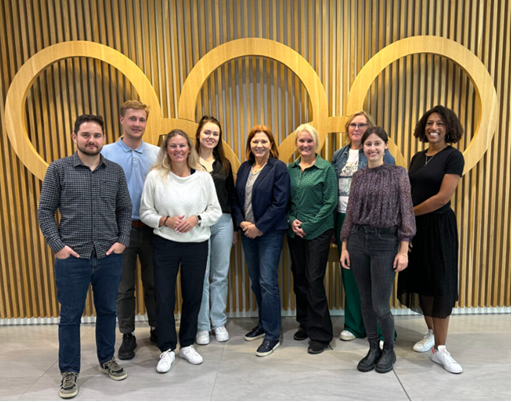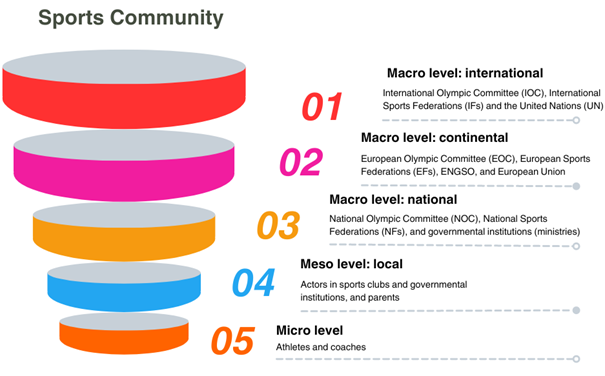
Building European Safe Sports Together: a conceptual framework of transgressive behaviour
Executive summary
The participation of European citizens in physical activities and sports varies based on their age, gender, or nationality. However, their involvement in sports provides physical, mental and social benefits for all, highlighting the value of sports. To promote sports participation, it is necessary to have actors on various levels – micro, meso and macro – who provide opportunities to participate in sports. The actors on these levels have different roles and purposes within the sports community, and they all have their individual influence. The micro level consists of athletes and coaches who form the group that participates in sports. On the other hand, the meso level includes individuals who contribute to providing opportunities for participation on a local level, such as board members of sports clubs, coaches of the coaches, and parents. Lastly, the macro level includes sports providers providing frameworks and policies to be implemented by the meso level on a local and (inter)national level, such as national and local governments and (inter)national sports federations. However, in addition to providing opportunities for sports participation, the actors at these three levels should take an essential condition into account: safety. All human beings have a fundamental right to access sports in a safe environment, so the sports community must safeguard this right. Unfortunately, it is well-known that a not-so-safe sports environment exists worldwide. Over the past few decades, researchers have studied individuals who have experienced harassment and abuse, resulting in harmful consequences as a result of their participation in sports. Moreover, harassment and abuse can occur at all levels of the sports community, not just the micro level. Therefore, establishing safeguards should be an integral part of the DNA of all levels of the sports community. For this reason, project BESST aims to create awareness of a shared responsibility among all actors involved in sports to ensure safe sports for any individual within the sports community.

Funnel diagram of actors and organisations per level in the sports community
Context-centred approach
It is important to acknowledge all forms of harassment and abuse that exist in sports and to establish a universal understanding of these practices to create a safe community. To achieve this, we need to move away from our tendency to categorise everything into boxes and instead focus on identifying all forms of harassment and abuse by taking a holistic view. This means that instead of starting with the concretisation and categorisation of different types of harassment and abuse, we should focus on the interpersonal dynamics of situations in which harassment and abuse occur. Project BESST is developing a conceptual framework based on a context-centred approach to achieve this goal. The approach takes into account the concept of sports ethics, which contains moral values and principles that guide ethical behaviour in sports. One of the goals of sports ethics is to protect individuals from any form of harassment and abuse in sports. However, the term “unethical behaviour” is quite abstract resulting in a grey area of ethical and unethical behaviour. It is also difficult to define whether it can be considered (un)ethical depending on the situation in which the behaviour occurs. Therefore, it is important to consider societal standards underlying behaviours that lead to harassment and abuse in sports.
Distribution of power
It is important to recognise the distribution of power within the sports community, as per Foucault’s theory. Power is seen as a relationship that guides someone’s behaviour and is not fixed on someone’s identity. Power is constantly changing and takes on different roles and effects in social interactions. Over time, communication has shaped power structures in society, leading to the formation of societal standards and knowledge that are seen as the ‘truth’ by society. For example, a traffic light is a ‘truth’ created by a society that everyone follows. Regarding harassment and abuse in sports, individuals may obtain or claim perceived power due to societal standards of ‘truths’. These individuals believe they have power over others because of their identity and force others to recognise this power. To intervene in this process, we must first identify it. We should not look at institutions, groups, or classes, but at the forms and techniques of power concerning communication: the discourses. Society has formed discourses causing individuals with particular characteristics, such as age, disability, ethnicity, sexual orientation, and gender, to be perceived as less significant within sports. They are perceived as ‘space invaders’ and are, therefore, likely to be marginalised. Marginalisation is about the ability of individuals to fit in or conform to the ‘truthful’ standards that are set. If someone fails to conform, they can be marginalised, creating an opportunity for harassment and abuse to occur. Underlying marginalisation is the societal construction of sexuality that keeps societal standards in existence. For example, taboos about sexuality originated from beliefs created by religion (e.g., unacceptance of same-sex relationships) or ‘truths’ emphasising the maintenance of a pure bloodline (e.g., no interracial marriage). These ‘truths’ of societal standards resulted in the development and maintenance of patriarchy, cisheteronormativity, and racialisation in our society. Unfortunately, these societal standards are also accepted as truths within the sports community, and actors at all levels are behaving accordingly.
Harassment and abuse in sports are a result of societal standards transferred from our society to the sports community. First of all, the patriarchal societal standards dictate that men are dominant and privileged in society. Men are expected to conform to these standards by behaving in a masculine manner. However, the presence of masculine discourses in sports can lead to inclusivity issues for men. Additionally, it is problematic that certain sports are labelled as ‘masculine’ (e.g., football) or ‘feminine’ (e.g., cheerleading), as this reinforces the idea that masculinity is associated with power. This can lead to a social hierarchy where those who do not conform to traditional masculine standards are marginalised. In addition to other forms of marginalisation, society’s adherence to cisheteronormative standards creates yet another process of exclusion. Society has established a rigid binary of gender identities, recognising only two mutually exclusive options: male (he/him) and female (she/her). Consequently, anyone who falls outside the boundaries of these societal norms regarding gender and sexuality is likely to experience marginalisation. Lastly, there is a process of marginalisation based on how society categorises an individual’s physical characteristics. People are grouped according to their race, resulting in a social order known as racialisation. Unfortunately, race is often used to view others as different, rather than as a cultural cue to help people interact with one another. This has resulted in the establishment of “truths” that view white ethnicity as superior to other ethnicities, creating a sense of inferiority among those who are not white. With this, it is important to note that these three societal standards are not exhaustive, as other factors may contribute to transgressive behaviours in sports. Our society plays a significant role in shaping our understanding of ‘truth’. As a result, these truths can change over time.
Theoretical framework
Project BESST provides a theoretical framework that helps individuals reflect on their perspective of harassment, abuse and safeguarding in the sports community. It encourages people to think outside the box and avoid categorising. The project aims to capture how people exhibit power, the context in which it happens, over whom it happens, and its effects. The project proposes a holistic view of harassment and abuse in sports by defining it as transgressive behaviour (TB) defined as “any form of misuse of relationships of power violating someone’s access to safe sports”. It acknowledges the presence of transgressive behaviour in three forms, namely sexual, psychological and physical, which can overlap and occur simultaneously in the sports community.
Our mission and vision are focused on “Building European Safe Sports Together”. Rather than focusing on negative behaviour, we aim to establish a safe and secure environment for everyone who wants to enjoy sports. To achieve this goal, the sports community must be proactive and responsive at the same time, ensuring that everyone has the right to access sports in a secure environment. Our theoretical framework emphasises two dimensions of safe sports: the relationship of power (utilising vs. misusing) and safeguarding (measures and actions being present vs. absent). Based on this theoretical framework, safe sports can be created in and by the sports community if relationships of power are utilised (i.e., empowerment) and safeguarding is present.
“Building European Safe Sports Together” can only be achieved through collective efforts. Therefore, all stakeholders, at every level of the sports community, should prioritise the safety of individuals involved in sports. Safeguarding should be an integral part of their DNA, and each stakeholder must feel a shared responsibility for ensuring safe sports. To accomplish this, we need to shift the balance of power in the sports community’s culture. The focus should be on empowering (marginalised) individuals and utilising the power dynamics in interpersonal relationships to achieve this goal. Instead of categorising behaviour and people in boxes, we need to adopt a holistic approach to building safe sports. Let’s work together to create new “truths” and build European Safe Sports Together.
For more information: https://besst-safesport.eu/
Project contact at UT: Marleen Haandrikman & Nicolette Schipper-van Veldhoven
